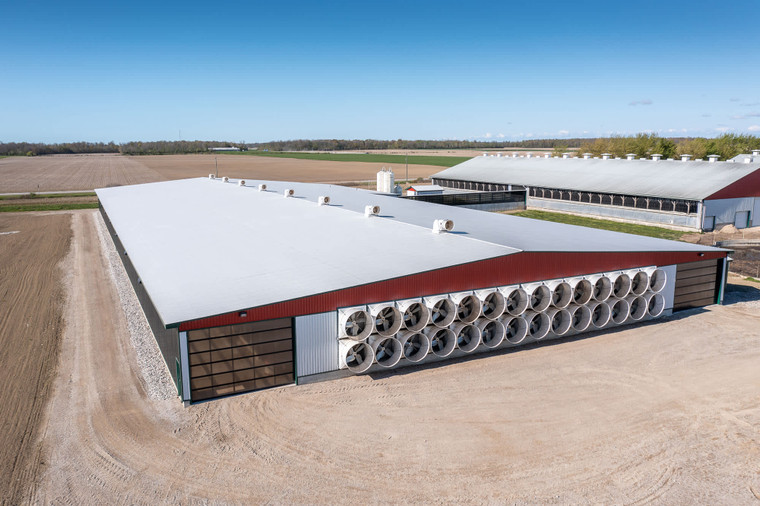How To Prepare Barn Ventilation For Spring And Summer
Feb 24, 2022
From hog houses to poultry broilers, ventilation is a year-round need that must be adapted to the climate and weather conditions of the area. While winter brings cold air and temperatures, spring and summer usually mean warmth and humidity.
In some parts of the United States, summer weather may be too warm for livestock. Having the right ventilation system and ensuring it’s prepared for warm weather is vital for the health and safety of your animals.
The Importance of Barn Ventilation
Barn ventilation systems replace indoor air with fresh air from outside. Air circulation is important not only for cooling, but biosecurity. Livestock housed in barns create heat, moisture, gasses, and dust.
Inadequate ventilation can lead to the build-up of potentially harmful gasses like ammonia or hydrogen sulfide. Meanwhile, excess moisture and debris can spread pathogens and harmful airborne particles. While these are concerns during winter, the warm weather brings its own challenges.
Excessive heat is among the largest concerns during the summer. In variable climates, active and passive barn ventilation are used for cooling. These methods rely heavily on a functioning ventilation system for maximum efficiency.
Before warmer springtime weather arrives, be sure to prepare your barn’s ventilation system. Here are a few tips to help you get your ventilation systems ready.
Inspect Passive Ventilation
Passive or “natural” ventilation includes anything that doesn’t require active, mechanical equipment, such as air inlets, vents, and windows. Most often, ridge vents are installed along the barn roof, allowing warm air to readily escape the barn as cooler air is pulled in by fans.
During the winter months, vents are often closed or sealed to keep warm air from escaping. Snow, ice, rain, and even animals or pests can damage the vents. Debris can also become trapped.
Check Vents & Curtains
As part of your springtime barn cleaning and preparation, be sure to inspect all vents and other forms of passive ventilation to ensure they’re functioning and clear of obstructions.
Doing this early, before spring, allows for time to repair and replace passive ventilation before it’s needed.
Finally, if your barn uses a curtain system, check that they’re unsecured, functioning properly, and the run times are correct.
Need to repair or replace your barn’s passive ventilation? Shop for ventilation equipment from Farmer Boy!
Test Active Cooling Systems
In many parts of the country, large production broiler houses and other livestock facilities will rely on both passive ventilation and active cooling.
Check Fans & Misters
Active cooling, like fans and fogging or misting systems, require power and, in some cases, a water supply. As you inspect ventilation, be sure to also test any active cooling systems to ensure they’re working properly.
Inspect Electrical Systems
Inspect all electrical and water lines connected to cooling systems. Ensure they’re connected and in good condition. Also check electrical switches and controllers to ensure these are working properly. Afterward, fully test run fans and other cooling systems from start-up to shut down.
If you have emergency fans on independent thermostats, check that both the fans and thermostats still work and are set correctly.
Prepare Cooling Pads
In warmer climates, your barn may need to use evaporative cooling pads in conjunction with fans. Prepare your cooling pads by removing winterizing covers and inspecting for pest damage.
Replace old or damaged barn cooling with new systems from Farmer Boy.
Adjust For Humidity
Winter and summer can have vast differences in humidity. Be sure you’re adjusting thermostat settings and fans to account for increased humidity. With higher humidity outside, you’ll also need to ensure you have a plan in place to reduce moisture caused by livestock.
Manage Manure & Waste
Livestock manure generates a significant amount of moisture and gases. In the spring and summer, the additional moisture in the air can add to the moisture produced by livestock waste.
Properly minitor inlets and recirculation ducts and regularly clean stalls to keep moisture and ammonia levels down during hotter weather.
Prepare For Severe Weather
Severe weather is common during the spring and summer. Be sure you’re prepared for everything from flooding to power outages.
High winds and heavy rains can damage property, including powerlines. If you experience severe weather in your area, have a back-up generator ready in case of power outages.
Keep Back-up Supplies
As part of your spring ventilation prep, schedule a time to test back-up power supplies. This will help ensure they’re running and functioning properly before you need them.
It’s also important to have the supplies and parts you need to make critical repairs to back-up equipment. Have gasoline for gas-powered generators on-hand. Also be sure to have extra electrical supplies, from fuses to surge protectors, ready for use.
Shop with Farmer Boy to find everything you need to keep your barn’s cooling and ventilation systems running smoothly throughout the warm months. If you need help finding a specific part or product, give us a call at 1-800-845-3374 for assistance!


